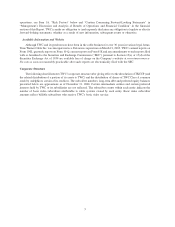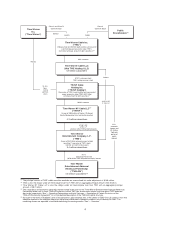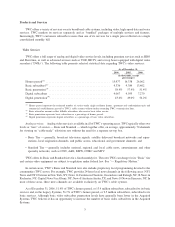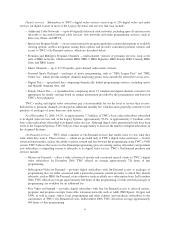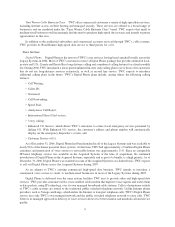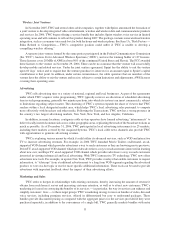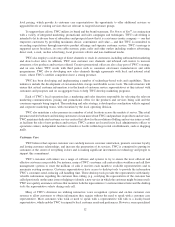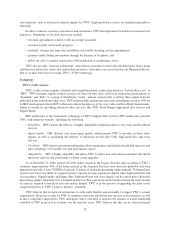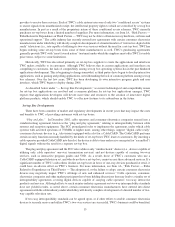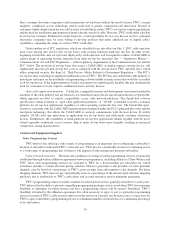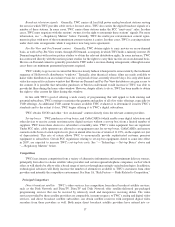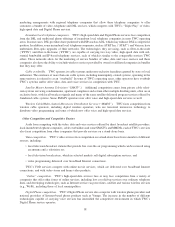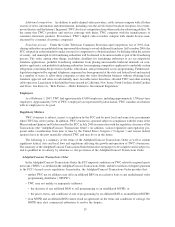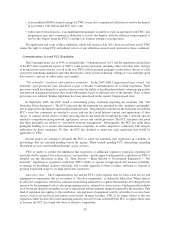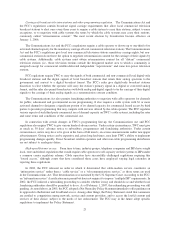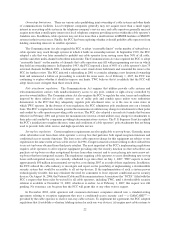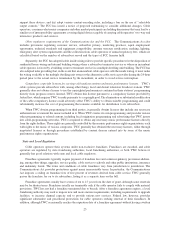Time Warner Cable 2006 Annual Report Download - page 18
Download and view the complete annual report
Please find page 18 of the 2006 Time Warner Cable annual report below. You can navigate through the pages in the report by either clicking on the pages listed below, or by using the keyword search tool below to find specific information within the annual report.care functions, such as advanced technical support for TWC’s high-speed data service, are handled regionally or
nationally.
In order to enhance customer convenience and satisfaction, TWC has implemented a number of customer care
initiatives. Depending on location, these may include:
• two-hour appointment windows with an on-time guarantee;
• customer loyalty and reward programs;
• weekend, evening and same-day installation and trouble-shooting service appointments;
• payment and/or billing information through the Internet or by phone; and
• follow-up calls to monitor satisfaction with installation or maintenance visits.
TWC also provides “Answers on Demand,” which allows customers to select discrete help topics from a menu
and then view interactive videos that answer their questions. Customers can access Answers on Demand either on-
line or on their television set (using TWC’s VOD technology).
Technology
TWC’s Cable Systems
TWC’s cable systems employ a flexible and extensible network architecture known as “hybrid fiber coax,” or
“HFC.” TWC transmits signals on these systems via laser-fed fiber optic cable from origination points known as
“headends” and “hubs” to a group of distribution “nodes,” and use coaxial cable to deliver these signals from the
individual nodes to the homes they serve. TWC pioneered this architecture and received an Emmy award in 1994 for
its HFC development efforts. HFC architecture allows the delivery of two-way video and broadband transmissions,
which is essential to providing advanced video services, like VOD, Road Runner high-speed data services and
Digital Phone.
HFC architecture is the cornerstone technology in TWC’s digital cable systems. HFC architecture provides
TWC with numerous benefits, including the following:
•Reliability. HFC enables the delivery of highly dependable traditional and two-way video and broadband
services.
•Signal quality. HFC delivers very clean signal quality, which permits TWC to provide excellent video
signals, as well as facilitating the delivery of advanced services like VOD, high-speed data and voice
services.
•Flexibility. HFC utilizes optical networking that allows inexpensive and efficient bandwidth increases and
takes advantage of favorable cost and performance curves.
•Adaptability. HFC is highly adaptable, and allows TWC to utilize new networking techniques that afford
increased capacity and performance without costly upgrades.
As of December 31, 2006, almost all of the homes passed in the Legacy Systems and, according to TWC’s
estimates, approximately 94% of the homes passed in the Acquired Systems were served by plant that had been
upgraded to provide at least 750MHz of capacity. Carriage of analog programming (approximately 70 channels per
system) uses about two thirds of a typical system’s capacity leaving capacity for digital video, high-speed data and
voice products. Digital signals, including video, high-speed data and voice signals, can be carried more efficiently
than analog signals. Generally 10 to 12 digital channels or their equivalent can be broadcast using the same amount
of capacity required to broadcast just one analog channel. TWC is in the process of upgrading the plant in the
Acquired Systems to TWC’s Legacy Systems’ standards.
TWC believes that its network architecture is sufficiently flexible and extensible to support TWC’s current
requirements. However, in order for TWC to continue to innovate and deliver new services to its customers, as well
as meet competitive imperatives, TWC anticipates that it will need to increase the amount of usable bandwidth
available to TWC in most of its systems over the next few years. TWC believes that this can be achieved largely
13


